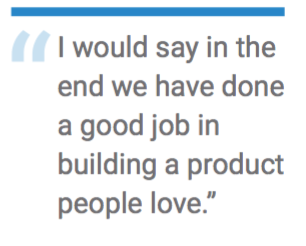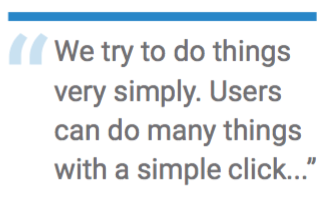An Insider’s View On Digital Banking’s Growth

Finding inspiration for banking’s future from … Spotify? While one might expect a digital bank to turn to major financial institutions for cues on how to build their offering, many are finding success instead from the likes of Facebook and Uber. In the July edition of the Digital Banking Tracker™, PYMNTS.com caught up with Valentin Stalf, co-founder and CEO of NUMBER26, who discussed his company’s inspiration and how its digital roots are helping it grow. Catch that, along with a ranking of 78 players from the FinTech and consumer banking spaces, as well as the latest news from around the industry inside this month’s issue of the Digital Banking Tracker™.
Traditional financial institutions have certain advantages over their new, and often much smaller, digital counterparts. Large, prominent banks typically have more resources, bigger customer bases and more experience working with consumers and financial markets.
But big banks don’t hold all the cards when it comes to the new digital landscape. Well-established financial institutions often have big costs and outdated existing technology, which can make them slow to react to trends and developments in the rapidly evolving digital banking space. Meanwhile, small, digital-only banks with deep roots in technology are able to shift nimbly, enabling them to more quickly react to consumer feedback in order to improve customer experience.
One of those online banks finding success – due in large part to its digital roots – is German bank Number26. PYMNTS caught up with Valentin Stalf, the company’s co-founder and CEO, to talk more about building a bank on the back of top-flight technology, the advantages and challenges that go with it, and what’s to come as digital banking steadily evolves.
The L-word and a banking app?
Stalf emphasized the importance of Number26’s foundation in technology, which he said allows the bank to be more receptive to customer feedback and build a better offering.
“One of our big advantages is that we are not locked into an old legacy system,” he said. “So we can actually build the bank of tomorrow based on the technology of today.”
Stalf said those roots give Number26 two key advantages: low costs and high customer satisfaction.
More customers than ever before are looking to use digital tools to improve their banking, just as they use them in almost all other areas of their life, Stalf noted. And, by basing its offering on digital technology, Number26 can offer more features than large, slower-moving institutions. As a result, Stalf said he believes that his offering has a leg up when it comes to customer satisfaction.
 “With our user experience, we do a much better job at the moment than most traditional banks,” Stalf said. He then cited Number26 as having been singled out by Apple as the only banking provider in Europe that is also a leading app in the digital giant’s App Store. “We have taken a different approach – we try to innovate banking without coming out of banking. It allows us to think much more freely on what we want to achieve and how it is achievable.”
“With our user experience, we do a much better job at the moment than most traditional banks,” Stalf said. He then cited Number26 as having been singled out by Apple as the only banking provider in Europe that is also a leading app in the digital giant’s App Store. “We have taken a different approach – we try to innovate banking without coming out of banking. It allows us to think much more freely on what we want to achieve and how it is achievable.”
In order to build that different approach, Stalf and his team did not look to other financial institutions for inspiration. Instead, they turned to popular tech-based companies in other industries – apps like Spotify, Uber or Airbnb.
“We looked at their customer experience for inspiration to build the best user experience in banking,” Stalf explained. He said that approach has led Number26 to be more innovative than many other banks. Then he took it slightly further. “I would say in the end we have done a good job in building a product people love.”
Giving customers what they want
Stalf noted that small companies like his are able to be more responsive to customer feedback than big banks because of cost rather than a lack of capability. He said that it costs a digital company like his much less to make shifts in technology or strategy than it does for long-established financial institutions. “If you look at our system and the scalable technology that we’re using, we’re in the position to offer an account at about 10 times lower costs than a traditional bank,” he said.
Additionally, Stalf said, those higher costs for traditional banks lead to an inability to take risks or implement innovative solutions.
“Their problem is that they’re paralyzed by their old legacy systems, which are slow to change,” Stalf said. “I think it’s our technology base that lets us think and act as freely as we do.”
In order to set themselves apart from other banks, Stalf and team introduced features designed to improve customer experience, including a streamlined registration process.
Rather than a traditional bank, which often requires a lot of paperwork and possibly hours or days to open an account, he said, “We have a fully digital sign-up. It takes only few minutes to type in your details. It is very similar to a Facebook sign-up from a user experience perspective,” he said, pointing again to popular apps Uber and Airbnb as being central inspirations for the digital banking innovation.
“We try to do things very simply. Users can do many things with a simple click, like blocking or unblocking their card or activating an overdraft. We do this to give the user transparency and control over their account,” he explained. “A lot of what we’re doing is enabled by the lean tech infrastructure we are based on. Most of the traditional banking systems are built with a backward-looking reporting focus, while our system has been built for real-time insights to give user transparency. That makes a big difference.”
From niche to established player – navigating the road ahead
Despite the alleged love and the sky’s-the-limit outlook, there are, of course, challenges as well. One of the biggest problems they have faced, Stalf said, is evolving the app’s features while also keeping it simple.
The company, which started out as an account and debit card offering, has become much more intricate. “One of the core challenges that we’re facing going forward is keeping our user experience simple as our product becomes more complex. How can we offer investments, savings and a consumer credit without losing the slick experience we have now? We are working on finding a way to make this possible,” he said.
He added that the company also struggles to keep pace with big banks when it comes to marketing and branding, as well as in solidifying its consumer perception as a top-flight financial institution. Number26, like many other digital offerings, started as a niche product. Now Stalf is trying to build a brand as both a full-service bank and a FinTech platform.
To do the latter, Stalf said, the company is going to begin rolling out new services, like insurance and credit products, by integrating FinTech partner specialists directly into the app. That, however, presents a new challenge, he said, as the brand will need to earn trust and a reputation for being more than just a “good transaction service.”
While becoming a larger and more complex company may be a challenge, Stalf said he intends to remain focused on the business’ digital roots, which he hopes will allow it to maintain an advantage over other banking options.“It is important to understand that from a business model perspective, it’s really about the technology that we’re using,” Stalf said. “The second thing is that we truly believe that the value of a bank is in the future not defined by their balance sheet they have but much more by the products and user experience they can offer. That’s why we are building our FinTech platform that we kicked off with the TransferWise integration and are currently working to expand.”
“It is important to understand that from a business model perspective, it’s really about the technology that we’re using,” Stalf said. “The second thing is that we truly believe that the value of a bank is in the future not defined by their balance sheet they have but much more by the products and user experience they can offer. That’s why we are building our FinTech platform that we kicked off with the TransferWise integration and are currently working to expand.”
To download the July edition of the Digital Banking Tracker™, click the button below.

About the Tracker
The PYMNTS Digital Banking Tracker™ brings you the latest news, research and expert commentary from the FinTech and consumer banking space, along with the rankings of more than 50 companies serving or powering the digital banking sector.
